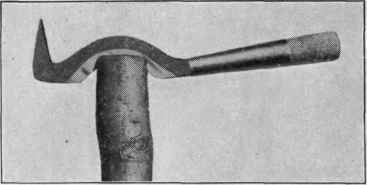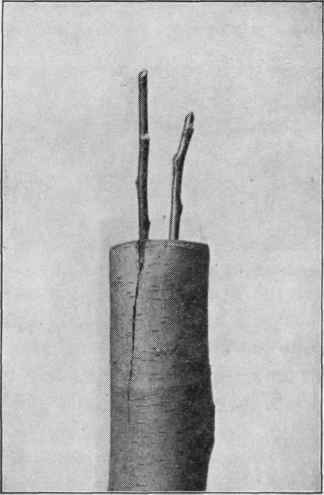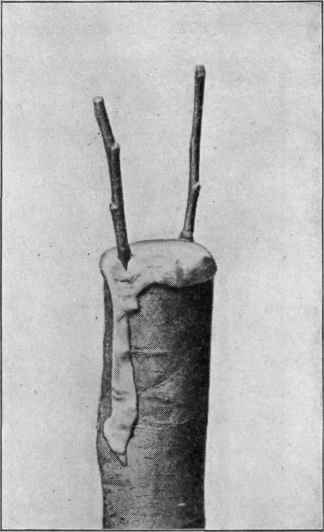Exercise XXXV. The Study Of Cleft Grafting And Bark Grafting
Description
This section is from the book "Laboratory Manual Of Horticulture", by George W. Hood. Also available from Amazon: Laboratory Manual Of Horticulture.
Exercise XXXV. The Study Of Cleft Grafting And Bark Grafting

Fig. 29. A very good type of grafting-chisel, showing the first position in cleft grafting.
Material. Stocks cut from apple or pear trees from one to two inches in diameter and from twelve to fifteen inches in length. Apparatus. Grafting-chisel, sharp knife, grafting-wax. These two forms of grafting are used principally for the top-working of old trees or for changing the variety of a large tree of inferior flavor. Occasionally they are used to replace large broken limbs. Cleft grafting is the form universally used in top-working or grafting in the limbs of a tree. It is limited to branches less than two inches in diameter, and is best suited to those between one inch and one and one-half inches in diameter. The two essential parts in this form of grafting are the stub (Fig. 29), or that part of the branch on which the grafting is performed, and the scion (Fig. 33). The scion is a twig taken from one-year-old wood, and should contain three or four strong, healthy buds. It is usually from four to six inches in length.
The scion is cut wedge-shaped, and the length of the wedge should be not less than one inch, but the cut can vary from one to one and one-half inches. The cut must be smooth, and made by two draws of the knife. The outer edge is usually a little thicker than the inner one, to insure the scion being held firmly.

Fig. 30. The second position of the grafting-chisel in cleft grafting.
The limb, or stub, is split either by a grafting-chisel (Fig. 30), of which two kinds are in common use, or by the ordinary wood chisel. The essential requisite is to have the knife equipped with a curved edge so as not to split the bark but rather to cut it, and this is best accomplished by a curved blade.
Cleft Grafting
1. Practice making several clefts and inserting the scions. Make a drawing, four inches in length and one and one-half inches in diameter, showing a stub and cut with the chisel in position. Show the length of the split along the side. Does this vary with each graft? What is the reason for this variation? Where is the cambium layer in the stub found?
Cut your scions, and insert two in each stub, slanting them outward at an angle of four or five degrees (Fig. 31). Now wax the stub over with grafting-wax. The wax should extend over the edge about a quarter of an inch and completely fill the split on both sides. Why?
2. Make a natural-size drawing of the scion. What is the distance to the first bud? Why should a small portion of the wood be left above the last bud? The top of the wedge-shaped cut should be near a bud. Why this precaution? Where is the cambium layer in the scion? How do you insure the cambium layer of the scion coinciding with that of the stock? Discuss.
3. Make a drawing, four inches in length, showing the scions in the stub after they have been waxed over (Fig. 32). The two scions should slant outward at an angle of about five degrees. Why? What is the purpose of the wax?

Fig. 31. Cleft graft, showing the scions in position in the stub before it is waxed over.
Bark Grafting
Bark grafting is employed on limbs that are too large for cleft-grafting. Limbs over two inches in diameter are best grafted in this way. Bark grafting is often employed to replace large limbs which have been destroyed.
The essential principle in this form of grafting is the same as that involved in cleft grafting. From three to twelve scions are placed in each stub, according to its size.

Fig. 32. Cleft graft, showing the stub after it has been waxed over.

Fig. 33. Scion for bark and cleft grafting.
The scions are cut very thin, with a shoulder on each side (Fig. 33). The cut should be at least one inch in length and not much more than one sixteenth of an inch in width. Why should this cut be so thin? Make a natural-size drawing of the scion, showing the shoulder. The scion should contain three or four well-developed buds.
1. Make a drawing, at least four inches in length and two and one-half inches in diameter, showing the stub and the location of each scion. In this method the scions are placed between the bark and the wood, and no cleft is made in the stub. A small penknife is convenient in making an opening into which the scion can be inserted. Why are the scions placed between the bark and the wood instead of being placed in a cleft in the stock? After the scions have been placed in the stock, wax the whole surface over with grafting-wax, allowing the wax to extend over the edge of the stub about one fourth of an inch.
2. Make a drawing, four inches in length, showing the scions in place, after the whole surface has been waxed over with grafting-wax. Label all parts. When is this form of grafting used? Discuss.
Continue to:


